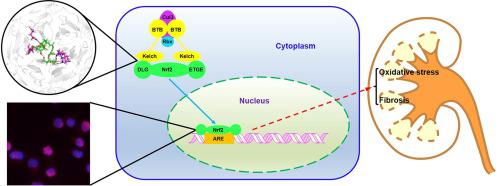Bioorganic & Medicinal Chemistry ( IF 3.5 ) Pub Date : 2020-10-31 , DOI: 10.1016/j.bmc.2020.115833 Huankai Yao 1 , Nan Zhang 1 , Wenting Zhang 2 , Jindong Li 3 , Huilian Hua 3 , Yan Li 1

|
Diabetic nephropathy (DN) is a severe microvascular complication of diabetes mellitus. High glucose has resulted in oxidative stress and following renal fibrosis as the crucial nodes of this disease. Nuclear factor erythroid 2-related factor 2 (Nrf2) is a transcription factor regulating transcription of many antioxidant genes and suppressing synthesis of extracellular matrix. To discover Nrf2 activators targeting DN, we have evaluated polypodiside using cell-based assays. The results showed polypodiside inhibited the high glucose-induced self-limited proliferation of glomerular meangial cells. Activation of Nrf2 and enhanced transcription to antioxidant response elements were observed in the presence of polypodiside. Oxidative stress and accumulation of extracellular matrix induced by high glucose in glomerular meangial cells have been ameliorated by polypodiside. Further investigations revealed the effects of polypodiside on glomerular meangial cells were associated with activation of Nrf2. Co-immunoprecipitation of Nrf2 disclosed polypodiside disrupted the Kelch-like ECH-associated protein-1 (Keap1)-Nrf2 interaction. Molecular docking elucidated polypodiside could enter the Nrf2 binding cavity of Keap1 via interacting with the residues encompassing that cavity. These findings indicate polypodiside is a Keap1-dependent Nrf2 activator affording the catabatic effects against oxidative stress and accumulation of extracellular matrix in glomerular meangial cells under high glucose.
中文翻译:

在高葡萄糖条件下发现多糖作为Keap1依赖性Nrf2激活剂可减轻氧化应激和肾小球系膜细胞中细胞外基质的积累
糖尿病肾病(DN)是糖尿病的一种严重的微血管并发症。高血糖已导致氧化应激和继发于肾纤维化的该疾病的关键节点。核因子红系2相关因子2(Nrf2)是一种转录因子,可调节许多抗氧化剂基因的转录并抑制细胞外基质的合成。为了发现靶向DN的Nrf2激活剂,我们已经使用基于细胞的分析方法评估了多甙。结果表明,多糖对高糖诱导的肾小球平均细胞的自限增殖具有抑制作用。在多糖苷存在下,观察到Nrf2的活化和向抗氧化剂反应元件的转录增强。多糖对人肾小球系膜细胞高糖诱导的氧化应激和细胞外基质的积累有改善作用。进一步的研究表明,多糖对肾小球平均细胞的作用与Nrf2的激活有关。Nrf2的免疫共沉淀揭示了多甙对Kelch-like ECH相关蛋白1(Keap1)-Nrf2相互作用的破坏。分子对接阐明的多肽苷可以通过与包围该腔的残基相互作用而进入Keap1的Nrf2结合腔。这些发现表明,Polypodiside是一种Keap1依赖性Nrf2活化剂,在高葡萄糖条件下,对氧化应激和肾小球平均细胞中细胞外基质的积累具有催化作用。进一步的研究表明,多糖对肾小球平均细胞的作用与Nrf2的激活有关。Nrf2的免疫共沉淀揭示了多甙对Kelch样ECH相关蛋白1(Keap1)-Nrf2相互作用的破坏。分子对接阐明的多肽苷可以通过与包围该腔的残基相互作用而进入Keap1的Nrf2结合腔。这些发现表明,Polypodiside是一种Keap1依赖性Nrf2活化剂,在高葡萄糖条件下,对氧化应激和肾小球平均细胞中细胞外基质的积累具有催化作用。进一步的研究表明,多糖对肾小球平均细胞的作用与Nrf2的激活有关。Nrf2的免疫共沉淀揭示了多甙对Kelch-like ECH相关蛋白1(Keap1)-Nrf2相互作用的破坏。分子对接阐明的多肽苷可以通过与包围该腔的残基相互作用而进入Keap1的Nrf2结合腔。这些发现表明,Polypodiside是一种Keap1依赖性Nrf2活化剂,在高葡萄糖条件下,对氧化应激和肾小球平均细胞中细胞外基质的积累具有催化作用。分子对接阐明的多肽苷可以通过与包围该腔的残基相互作用而进入Keap1的Nrf2结合腔。这些发现表明,Polypodiside是一种Keap1依赖性Nrf2活化剂,在高葡萄糖条件下,对氧化应激和肾小球平均细胞中细胞外基质的积累具有催化作用。分子对接阐明的多肽苷可以通过与包围该腔的残基相互作用而进入Keap1的Nrf2结合腔。这些发现表明,Polypodiside是一种Keap1依赖性Nrf2活化剂,在高葡萄糖条件下,对氧化应激和肾小球平均细胞中细胞外基质的积累具有催化作用。



























 京公网安备 11010802027423号
京公网安备 11010802027423号